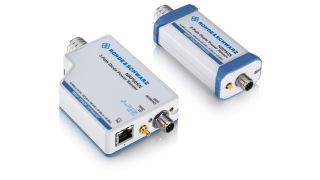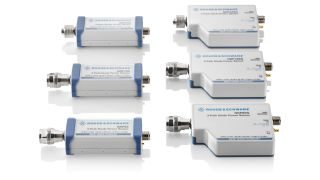Key facts
- Fast and accurate power measurements for CW and modulated signals
- 100,000 readings/s
- Control and monitoring via LAN and USB
- Sensors for high-power applications
- Flexible operation with R&S®NRX base unit







Key facts
The R&S®NRPxxS/SN power sensors use three separate diode paths, each operated in the optimum detector range. As a result, the average power can be determined with high accuracy independent of the modulation type. Measurement results are hardly affected by interfering signals or harmonics. The R&S®NRPxxS/SN power sensors therefore behave in a way similar to thermal power sensors but offer significantly higher speed. They provide up to 93 dB dynamic range with an excellent lower measurement limit of –70 dBm.
Quick links
Ideal solution for many applications
Three-path diode power sensors are suitable for numerous applications, since they support continuous average, burst average, timeslot average, gate average and trace measurements. Featuring outstanding performance and unprecedented measurement speed and accuracy, the sensors can be used to perform precise average power measurements on wireless signals such as GSM and 3GPP as well as on higher bandwidth signals such as LTE, LTE-Advanced or 5G.

Just a small part of the R&S®NRPxxS(N) family
Improved thre-path concept
The R&S®NRPxxS(N) power sensors use three separate diode paths, each operated in the optimum detector range. The average power can be determined with high accuracy irrespective of the modulation type. Measurement results are hardly affected by interfering signals or harmonics. The R&S®NRPxxS(N) power sensors therefore behave similar to thermal power sensors but offer significantly higher speed and up to 93 dB dynamic range.

Innovative three-path concept
Even at low levels down to -70 dBm
To increase measurement accuracy at low levels, it is necessary to average multiple measured values. While averaging reduces the noise component, it also slows down the measurement. The R&S®NRPxxS(N) power sensors have therefore been designed with an extremely low measurement noise in mind.
The R&S®NRPxxS(N) power sensors can perform measurements down to a lower limit of –70 dBm with the highest speed and accuracy currently available on the market.
Unlimited time measurement with up to 100.000 measurements/s
In fast continuous average mode, the R&S®NRPxxS(N) power sensors can perform up to 100,000 triggered measurements/s with a minimum trigger repetition time of 100 µs without losing any measurement. This measurement speed is achieved by using the buffered mode. In buffered mode, all measured data is collected inside the sensor and transmitted in one block to the sensor’s host. The R&S®NRPxxS(N) sensors perform the new fast mode without time limitation!
Perform power measurements up to 30 W
The R&S®NRP18S-10, R&S®NRP18S-20 and R&S®NRP18S-25 high-power three-path diode power sensors consist of an R&S®NRP18S and a 10/20/25 dB upstream attenuator. They are able to perform power measurements up to 2 W, 15 W and 30 W. When used with the attenuator, mismatch errors between the sensor and attenuator are automatically corrected. The S-parameters for the attenuator are determined and stored in the sensor during production.

Specially designed for use in thermal vacuum (TVAC) chambers
The R&S®NRPxxSN-V TVAC-compliant power sensor is designed for satellite communications applications in a frequency range up to 67 GHz. All components are baked in a vacuum chamber during the production process, so outgassing is reduced to a minimum. Thanks to their LAN capability, the power sensors can be easily controlled and monitored from outside the chamber while the venting holes in the housing ensure pressure equalization.

Order number 1425.2442.02
USB-C interface cable, length: 0.75 m
Order number 1425.2442.03
USB-C interface cable, length: 1.5 m
Order number 1425.2442.04
USB-C interface cable, length: 3.0 m
Order number 1419.0664.02
6-pole interface cable, length: 1.5 m
Order number 1419.0664.03
6-pole interface cable, length: 3 m
Order number 1419.0664.04
6-pole interface cable, length: 5 m
Order number 1424.9408.02
8-pole interface cable, length: 1.50 m
For connection to R&S®NRX
Order number 1424.9408.03
8-pole interface cable, length: 3.00 m
For connection to R&S®NRX
Order number 1424.9408.04
8-pole interface cable, length: 5.00 m
For connection to R&S®NRX
Order number 0240.2187.06
Documentation of calibration values
Order number 1173.6506.02
Printout of DCV
Manufacturer's recommended retail price (MSRP). The price shown does not include VAT. Prices and offers are only intended for entrepreneurs and not for private end consumers.
You may use the electronic signature via DocuSign to submit your information to enroll with the Rohde & Schwarz Customer Delegated Administration program. DocuSign processes the information provided according to their . The minimum system requirements for using the DocuSign system may change over time. The current system requirements are found
Terms & Conditions of the Prize Draw 10 years Rohde & Schwarz oscilloscopes
1. The prize draw “10 years Rohde & Schwarz oscilloscopes” (herein referred to as “Draw”) is organized by Rohde & Schwarz GmbH & Co. KG, Mühldorfstraße 15, 81671 Munich, Germany, Tel. +49 89 41 29 0 (herein referred to as “R&S).
2. All participators can register to the draw during January 01, 2020 to December 31, 2020 with their name, company name and business e-mail.
3. Participation is free of charge and not dependent on the purchase of goods or services.
4. The draw is only open to legal entities and only the legal entities are able to win the prizes. An individual person is not allowed to participate on its own name and its own account but as a representative of a legal entity filing the participation form in the name of and on behalf of the legal entity.
5. The prizes to win are 1 of 10 R&S®RTB2000 within the time frame January 1, 2020 to December 31, 2020:
Prize: 1x R&S®RTB2000 Digital Oscilloscope
6. The draw takes place at Rohde & Schwarz headquarters, Muehldorstrasse 15, 81671 Munich. The winner of the prizes will be informed by e-mail within 5 (5) working days.
7. The authorized representative of the legal entity shall inform Rohde & Schwarz about the acceptance of the price. In case of the denial of the acceptance, or no answer within two (2) weeks, a new winner will be drawn. If no winner can be determined within four (4) weeks, the draw ends and the prize forfeit.
8. R&S’ employees and members of their families and also person being familiar with the process of the draw and members of their families are excluded from filling the participation form.
9. No cash equivalent or exchange of prizes is allowed. Prizes are non-transferable. All taxes, levies, duties, fees and other charges levied in the participant´s country shall be borne by the participant.
10. Personal data will be processed only for the purpose of this prize draw and deleted four (4) weeks after the draw, if not agreed otherwise.
11. Any Participant who does not comply with these Terms & Conditions may be disqualified by R&S from this Competition. In such cases, prizes can also be withdrawn retrospectively. In case a prize is withdrawn retrospectively due to the non-compliance with these Terms & Conditions, it shall be returned by the respective participant at his cost to R&S’ address mentioned under Nr.1 and a new winner will be drawn.
12. The participants cannot claim the prizes of this draw and no legal recourse is permitted in this respect.
13. The draw and any contractual relationship arising therefrom between R&S and the respective participant shall be governed by and construed in accordance with the laws of Germany, without any recourse to the conflict of laws. The courts of Munich, Germany, shall have exclusive jurisdiction in case of any disputes arising directly or indirectly from the participation in this Competition.
* “fast delivery” inside 7 working days applies to the Rohde & Schwarz in-house procedures from order processing through to available ex-factory to ship.

